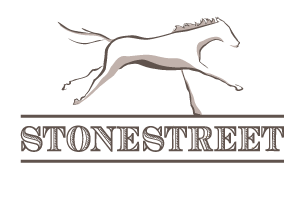At Stonestreet, our horses spend most of their time in fields and paddocks, enjoying the fresh air. This time outside is important for fitness as well as nutrition. The time spent grazing is essential to the health of every horse on the farm and making sure that they are receiving the best grass possible begins with aeration.
Aeration describes the use of a tool to puncture the ground. The small holes created allow oxygen and water to permeate further into the soil, reaching the roots of the grass. Aeration also breaks up any compacted ground that prevents sufficient root growth. Deeper roots mean stronger grass.
You may have an aerator for your yard at home that has rotating disks with small teeth that pierce the ground. With just over 1800 acres of fields and paddocks in Kentucky, we use a specially designed pull behind aerator. The aerator is pulled by a tractor and has a width of 10 feet. Rotating spikes between 6 and nine inches long called “tines” are pressed into the soil by the weight of the aerator and can pierce as deep as 8 inches into the ground.
Aeration is performed three times each year: in early spring before the first mowing, mid-summer, and early fall. It is important that the ground is soft enough for the tines to break the ground. If the ground is frozen or there has been little rain and is too hard, the tines can break. As the tractor pulls the aerator through a field, the operator will monitor frequently during and after each pass to check for broken or weak tines.
With 10-foot wide aerators, two tractors work large fields in a pair while a single tractor aerates the smaller paddocks. The tines enter straight into the ground so that the grass roots can access water and oxygen, but are not destroyed. The three tractors go from farm to farm and have every inch of grass aerated at a rate of one farm per week.
For their safety, horses are kept inside when aeration is being performed on their paddocks and fields. The farm is completed in sections so that each horse can return to turn out as quickly as possible. The slits created by the aerator are very small and the ground remains even meaning there is no effect on the horses’ ability to walk and run safely once they return to their fields.
Without aeration, grass will not receive the optimal amount of oxygen and water and ultimately does not grow as strong and tall. Aeration offers a chemical-free, effective solution that causes no harm to grazing horses while providing them optimal nutrition.
